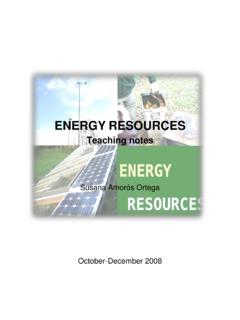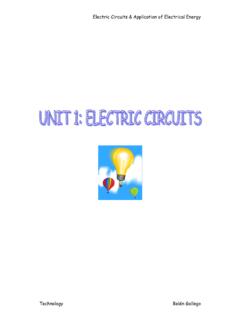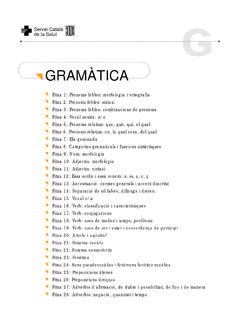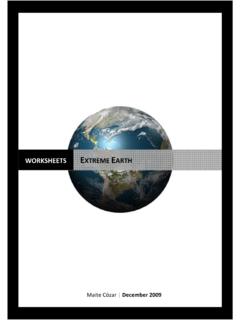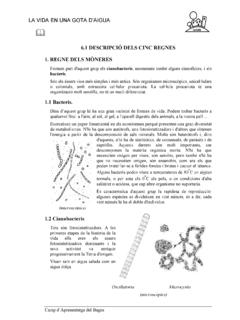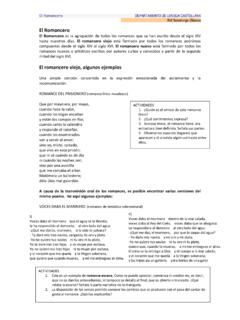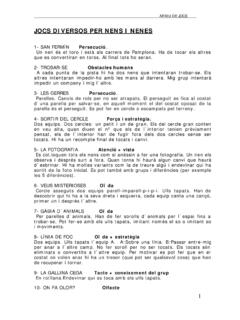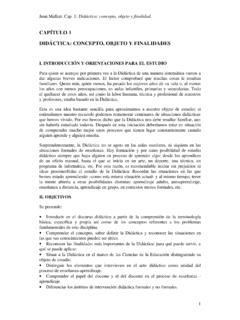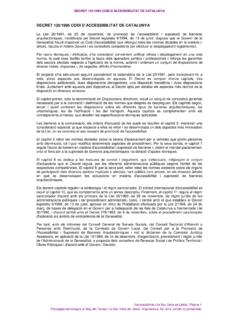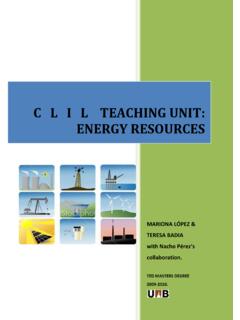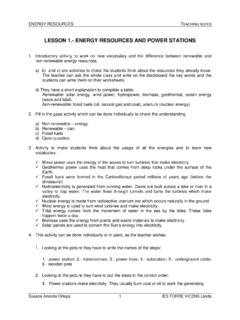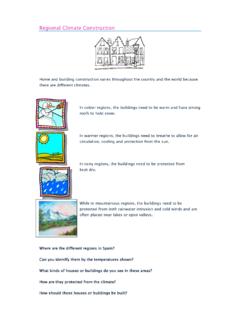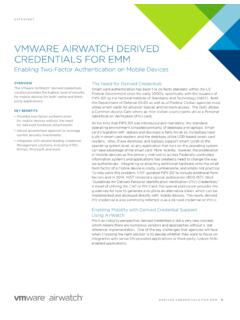Transcription of ENERGY RESOURCES - XTEC
1 ENERGY RESOURCES . Student worksheets Susana Amor s Ortega October-December 2008. ENERGY RESOURCES STUDENT WORKSHEETS. LESSON ENERGY RESOURCES AND POWER STATIONS. What are ENERGY RESOURCES ? 1. ENERGY RESOURCES . a) In pairs, think about different kinds of ENERGY used to produce electricity. Make a list (if you don't know the word in English, you can draw a picture). b) Whole group discussion. In turns, tell your classmates which are the ENERGY . RESOURCES you have written. We think that _____ can produce electricity. _____ is used to produce electricity. c) Complete the grid writing the name of the following ENERGY RESOURCES . Susana Amor s Ortega 1 IES TORRE VICENS Lleida ENERGY RESOURCES STUDENT WORKSHEETS. d) Are these ENERGY RESOURCES renewable or non-renewable?
2 Read the following text and complete the table below. ENERGY RESOURCES provide us with ENERGY . There are different types of ENERGY RESOURCES , including fossil fuels such as coal or oil, and stores of ENERGY such as batteries or the wind. We can divide ENERGY RESOURCES into two categories, non-renewable and renewable. Non-renewable ENERGY RESOURCES cannot be replaced once they are all used up. That means they cannot be renewed or replenished. Once they are gone they cannot be used again. Renewable ENERGY RESOURCES can be replaced, and will not run out (finish). RENEWABLE NON-RENEWABLE. Solar ENERGY Susana Amor s Ortega 2 IES TORRE VICENS Lleida ENERGY RESOURCES STUDENT WORKSHEETS. 2. Complete these sentences using the most suitable word: a) Coal, natural gas and oil are all _____ (renewable / non-renewable).
3 ENERGY RESOURCES . They release _____ ( ENERGY / electricity) when they are burned. b) Wind and solar ENERGY are _____ (renewable / non-renewable) because they _____ (can / cannot) be replaced. c) Coal, natural gas and oil are called _____ (nuclear fuels / fossil fuels). d) Two more examples of renewable energies are _____ and _____. 3. Match each kind of ENERGY with the correct sentence. Underline the key words is generated from running water. Dams are built across a lake or Wave power river in a valley to trap water. The water flows through tunnels and turns the turbines which make electricity. Geothermal power are used to convert the Sun's ENERGY into electricity. comes from the movement of water in the sea by the tides. Fossil fuels These tides happen twice a day.
4 Uses the ENERGY of the waves to turn turbines that make Hydroelectricity electricity. uses the ENERGY from plants and waste materials to make Nuclear ENERGY electricity. is made from radioactive uranium ore which occurs naturally in Wind ENERGY the ground. uses the heat that comes from deep rocks under the surface of Tidal ENERGY the Earth. were formed in the Carboniferous period millions of years ago Biomass (before the dinosaurs!). Solar panels is used to turn wind turbines and make electricity. Susana Amor s Ortega 3 IES TORRE VICENS Lleida ENERGY RESOURCES STUDENT WORKSHEETS. The electricity journey: from power stations to our homes 4. Look at the picture. Electricity is produced in power stations and it travels a long way before arriving at our homes.
5 This power station is used to produce electricity from coal, natural gas, oil or nuclear ENERGY . Electric journey: from power station to home (Source: UK). a) Write the names of the different steps (1-6) in the chart above using the words in the box. power lines / grid wooden pole power station substation transformers underground cable Susana Amor s Ortega 4 IES TORRE VICENS Lleida ENERGY RESOURCES STUDENT WORKSHEETS. b) Match each number with the step of the process: In some areas, cables are carried to buildings on wooden poles. Small local substations reduce the voltage to 230 Volts for houses, schools and businesses. In towns, most cables are underground. Power stations make electricity. They usually burn coal or oil to work the generating machinery In towns and cities there are more transformers in substations.
6 These change the electricity down to 11,000 Volts. The electricity is carried along thick metal cables called power lines. Some of them are carried overhead on pylons. Transformers change the voltage of the electricity up to 400,000. Volts so it can travel long distances. c) Write the process in the correct order: First _____. _____. After that _____. _____. _____. Then _____. _____. Finally_____. d) Draw the flow diagram of the process: Susana Amor s Ortega 5 IES TORRE VICENS Lleida ENERGY RESOURCES STUDENT WORKSHEETS. e) Work in pairs. One student (S1) asks 5 questions and the other student (S2). answers looking at the picture of the electric journey. Then, change the roles. Example: S1. Where is electricity produced? S2.
7 In . S1. How is electricity transported? S2. By . S1. Why ? S2. Because . S1. What is for? S2. For . S1. Which is the first / next / last step? S2. Each student writes his/her questions and the answers: Susana Amor s Ortega 6 IES TORRE VICENS Lleida ENERGY RESOURCES STUDENT WORKSHEETS. LESSON FOSSIL FUELS: COAL, OIL AND NATURAL GAS. 1. Put the pictures in the correct order. 2. Match each picture with the suitable text. 3. Explain the process of how coal was formed. 4. Make sentences with the information in the table. from sea plants and animals COAL from plants in swamps was formed in oceans OIL 100 million years ago 50-100 million years ago Susana Amor s Ortega 7 IES TORRE VICENS Lleida ENERGY RESOURCES STUDENT WORKSHEETS.
8 5. Look at the diagram in the PowerPoint presentation. Put the steps of the process in the correct order. The turbines The electricity The steam The oil is Crude oil is turn the flows into the pushes the burned to heat delivered to the generators, grid turbines, water, power station which create forcing them to producing electricity spin very fast steam Write the process of electricity production looking at the diagram in the power point presentation. First, _____. _____. After that, _____. _____. Then, _____. _____. Eventually _____. _____. 6. Look at the diagram of a coal-fired power station and watch the video. Describe the process: First, _____. _____. After that, _____. _____. Then, _____. _____. Finally _____. _____.
9 7. Draw the flow chart of the process of electricity production. Susana Amor s Ortega 8 IES TORRE VICENS Lleida ENERGY RESOURCES STUDENT WORKSHEETS. 8. Write the advantages and disadvantages of using fossil fuels. ADVANTAGES DISADVANTAGES. 9. Answer the questions: What's the greenhouse effect? Why do power stations powered by fossil fuels increase global warming? How is the acid rain produced? Susana Amor s Ortega 9 IES TORRE VICENS Lleida ENERGY RESOURCES STUDENT WORKSHEETS. LESSON NUCLEAR POWER. 1. Go to the website about nuclear ENERGY : Fill in the gaps with the words in the box below. a) Is nuclear power renewable? _____. b) Nuclear power stations use_____ as fuel. They need very little, compared to a "fossil" power station because there is much more _____ in nuclear fuel.
10 C) The _____ reaction inside the _____ creates heat, which turns _____. into steam to drive _____, which drive generators to make electricity. d) _____ power stations do not create atmospheric pollution, because they do not _____anything. However, the small amount of _____ that they do produce is very _____. Nuclear - burn - chain - dangerous - ENERGY - reactor - turbines - uranium - waste - water 2. Label the picture of the nuclear power station with the words in the box. Source: Wikimedia commons Susana Amor s Ortega 10 IES TORRE VICENS Lleida ENERGY RESOURCES STUDENT WORKSHEETS. cooling tower reactor river control rod steam generator transformer condenser turbine water vapour pump generator 3. Explain the process by using all the words you have in the box above: 4.
